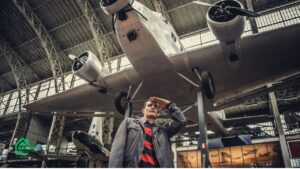Have you ever looked up at the sky and wondered about the story behind a specific plane soaring overhead? Many aircraft have incredible histories, and the tale of N427SA is a particularly fascinating one. This isn’t just any aircraft; it’s a piece of aviation history with a rich and complex past that has captivated enthusiasts for years.
The journey of N427SA involves remarkable service, mysterious ownership changes, and a legacy that extends far beyond its physical frame. It represents a unique chapter in the story of American aviation, filled with intrigue and impressive engineering. This article will explore the complete history of this amazing machine, from its origins to its final flight.
N427SA: At a Glance
To understand the story, it helps to first know the machine. Here’s a quick look at the key specifications of the aircraft registered as N427SA.
| Specification | Detail |
|---|---|
| Aircraft Type | Beechcraft C-12C Huron |
| Registration Number | N427SA |
| Serial Number | BD-002 |
| Year of Manufacture | 1978 |
| Engine Type | Twin Turboprop |
| Engine Model | Pratt & Whitney Canada PT6A-41 |
| Original Operator | United States Army |
| Known Status | Deregistered; Scrapped |
The Birth of a Workhorse: The Beechcraft C-12 Huron
To truly appreciate the story of N427SA, we must first understand the aircraft type it belongs to. The Beechcraft C-12 Huron is the military designation for a series of twin-engine turboprop aircraft based on the civilian Beechcraft Super King Air and Beechcraft 1900. It was designed to be a versatile, multi-purpose transport vehicle.
These planes were the unsung heroes of military logistics. They were not fighter jets grabbing headlines but were indispensable for moving personnel and light cargo between bases, both domestically and internationally. Their reliability and adaptability made them a cornerstone of military transport fleets for decades.
A Versatile and Dependable Platform
The C-12 series was celebrated for its rugged construction and ability to operate from shorter, less-prepared runways. This capability was a game-changer, allowing access to remote locations that larger transport planes couldn’t reach.
Pilots and crew who worked with the C-12 often praised its dependable performance. It was an aircraft built to endure demanding operational tempos, flying countless missions without the glamour of more famous military planes. The legacy of the C-12 platform is one of quiet, consistent excellence. The story of N427SA is deeply rooted in this tradition of service.
The Early Years: A Life of Military Service

The aircraft that would one day become known as N427SA began its life under a different identity. With the serial number BD-002, it was delivered to the United States Army in the late 1970s. During its military career, it flew under the tail number 79-23253.
As part of the Army’s fleet, 79-23253 served diligently. It was a crucial asset for transporting key personnel, including officers and dignitaries, as well as essential light cargo. The aircraft played a vital role in the complex logistical network that supports military operations around the globe. Imagine the important conversations and decisions that took place within its cabin as it shuttled leaders between strategic locations.
From Military Service to Civilian Life
After years of dedicated service, the aircraft was retired from the military. This is a common path for many military planes; as newer models are introduced, older ones are decommissioned and often sold for civilian use.
In October 1999, the aircraft’s journey took a significant turn. It was officially registered with the Federal Aviation Administration (FAA) under the new tail number N427SA. This marked the beginning of its second life, a chapter that would prove to be even more intriguing than its first. The transition from a military workhorse to a civilian aircraft is where the mystery truly begins.
The Stevens Express Leasing Era
Upon entering civilian life, N427SA was registered to a company named Stevens Express Leasing, Inc., based in Mena, Arkansas. Mena is a small city, but within the world of aviation and intelligence, it has a surprisingly prominent history, often associated with covert operations and clandestine activities.
The registration to a Mena-based company immediately added a layer of intrigue to the story of N427SA. For aviation enthusiasts and investigative journalists, Mena is a keyword that sparks immense curiosity. The town’s airport, Mena Intermountain Municipal Airport, was famously linked to CIA operations during the 1980s.
What Was Stevens Express Leasing?
Stevens Express Leasing was not a well-known entity. It appeared to be a holding company, a corporate structure often used to manage assets like aircraft while obscuring the true ownership. The lack of a clear public profile for the company only fueled speculation about the true purpose and ownership of N427SA.
This period of the aircraft’s life is shrouded in questions. Who was behind Stevens Express Leasing? What was their intention for acquiring a former military transport plane? The answers are not straightforward, and this ambiguity is a core part of the mystique surrounding N427SA.
The Infamous Association: Links to Barry Seal and Covert Operations
The most controversial and captivating part of the N427SA story is its alleged connection to Barry Seal. Adler Berriman “Barry” Seal was a pilot and drug smuggler who became a key figure in the Medellín Cartel’s operations in the United States. He later turned into a crucial informant for the Drug Enforcement Administration (DEA).
Seal operated a sophisticated smuggling enterprise out of Mena, Arkansas, using a fleet of aircraft to transport large quantities of drugs into the U.S. His story is a complex web of crime, espionage, and government complicity that has been the subject of books, documentaries, and even a major Hollywood film.
Did Barry Seal Own or Use N427SA?
The direct link between Barry Seal and N427SA is a subject of intense debate. While Seal was known to have used several aircraft for his smuggling operations, concrete, verifiable evidence placing him in the cockpit of N427SA is elusive.
However, the circumstantial evidence is compelling:
- Location: The aircraft was registered to a company in Mena, Arkansas, Seal’s primary base of operations.
- Aircraft Type: The C-12 Huron, with its military-grade performance and ability to carry significant loads, was an ideal aircraft for smuggling. Its robust nature would have been perfect for Seal’s high-risk flights.
- Timing: The aircraft’s civilian registration period overlaps with a time of heightened scrutiny into activities at the Mena airport.
Many researchers and authors who have studied Seal’s life believe that N427SA was part of his fleet, or at least part of the broader network of aircraft used in the Mena operations. The mysterious ownership under Stevens Express Leasing is seen by many as a classic tactic to hide assets used in illegal activities. The plane N427SA became a symbol of the shadowy dealings that took place in Mena.
User Reviews and Pilot Perceptions
While you won’t find “user reviews” for N427SA on a typical consumer website, we can look at the perceptions of pilots and maintenance crews who worked on the C-12 Huron series. The feedback is overwhelmingly positive, highlighting the aircraft’s reliability and performance.
Pilot Testimonials on the C-12 Platform
- “An Absolute Workhorse”: Many former military pilots refer to the C-12 as one of the most reliable aircraft they’ve ever flown. It was known for its ability to take off and land in difficult conditions and for its forgiving flight characteristics.
- “Spacious and Practical”: For a turboprop of its size, the cabin was considered spacious and easily configurable for either passengers or cargo. This flexibility is what made it so valuable for logistical missions.
- “Maintenance Friendly”: Maintenance crews often appreciated the straightforward design and the durability of the Pratt & Whitney engines. The aircraft was built to be serviced in the field, a critical feature for military use.
These perceptions paint a picture of an aircraft that was loved by those who flew and maintained it. This reputation for dependability makes its alleged use in high-stakes smuggling operations even more fascinating. The very qualities that made N427SA a great military asset also made it an excellent tool for clandestine activities.
The Final Chapter: Deregistration and Fate
The operational life of N427SA came to an end in the early 2000s. Aviation records show that its FAA registration was officially canceled. The reason cited was that the aircraft had been “destroyed” or permanently taken out of service.
The end of the N427SA story is as unceremonious as its beginning was dutiful. Most reports indicate that the aircraft was eventually scrapped for parts. This is a common fate for older planes, especially those with complex or controversial histories. It’s often more economical to salvage valuable components like engines and avionics than to maintain an aging airframe.
Why Was N427SA Scrapped?
Several factors likely contributed to the decision to scrap N427SA:
- Age and Maintenance Costs: As an aircraft built in 1978, the costs of maintaining it to modern safety standards would have been substantial.
- Controversial History: The association with Mena and Barry Seal may have made the aircraft a liability. Owning a plane with such a notorious past could attract unwanted attention.
- Economic Value: The sum of its parts—particularly the valuable PT6A turboprop engines—was likely worth more than the aircraft as a whole.
The scrapping of N427SA means that this piece of history no longer exists in its complete form. However, its story lives on, preserved in aviation databases, investigative reports, and the memories of those who study this intriguing period of American history. The tale of N427SA is a powerful reminder that every machine has a story.
The Enduring Legacy and Cultural Impact
Why does the story of a single aircraft, N427SA, continue to resonate with so many people? Its legacy is about more than just metal, wires, and engines. It’s a symbol of a turbulent and often hidden side of modern history.
The narrative of N427SA touches on several powerful themes:
- The Duality of Technology: It shows how a piece of technology designed for noble service (military transport) can be co-opted for criminal enterprise.
- Unanswered Questions: The story is full of mysteries, particularly regarding its ownership and exact use during the Mena period. This ambiguity fuels endless speculation and investigation.
- A Tangible Link to History: For many, N427SA is a physical object that connects the abstract stories of covert operations and smuggling rings to the real world. It makes a complex historical event feel more concrete.
The fascination with N427SA is unlikely to fade. It serves as a case study for journalists, a puzzle for aviation historians, and a thrilling tale for anyone interested in stories of espionage and adventure. The memory of N427SA is a testament to its incredible journey.
Frequently Asked Questions (FAQs)
Here are some common questions people have about the aircraft known as N427SA.
What kind of plane was N427SA?
N427SA was the civilian registration number for a Beechcraft C-12C Huron, a twin-turboprop aircraft originally used by the U.S. Army for transport. Its military serial number was 79-23253.
Is there proof that Barry Seal flew N427SA?
There is no definitive public record, like a pilot’s logbook, that proves Barry Seal personally flew N427SA. However, the aircraft was registered in his home base of Mena, Arkansas, to a mysterious leasing company, and its capabilities matched the types of planes he used for his smuggling operations. The connection is largely based on strong circumstantial evidence.
Where is the aircraft N427SA today?
The aircraft N427SA no longer exists. Its FAA registration was canceled, and it was reportedly dismantled and scrapped for parts in the early 2000s. Its components may have been used in other aircraft, but the original airframe is gone.
Why is Mena, Arkansas, significant to this story?
Mena Intermountain Municipal Airport became notorious in the 1980s as the base for Barry Seal’s large-scale drug smuggling and gun-running operations. It was also allegedly a site for covert CIA activities. The fact that N427SA was registered there is a major reason for its infamy.
Was the N427SA aircraft unique?
As a C-12C model, it was one of many built. However, its specific history—serving in the military, being sold into civilian life, and its connection to the shadowy events in Mena—makes the story of N427SA absolutely unique and a subject of enduring fascination. The journey of N427SA remains a standout in aviation lore.

















